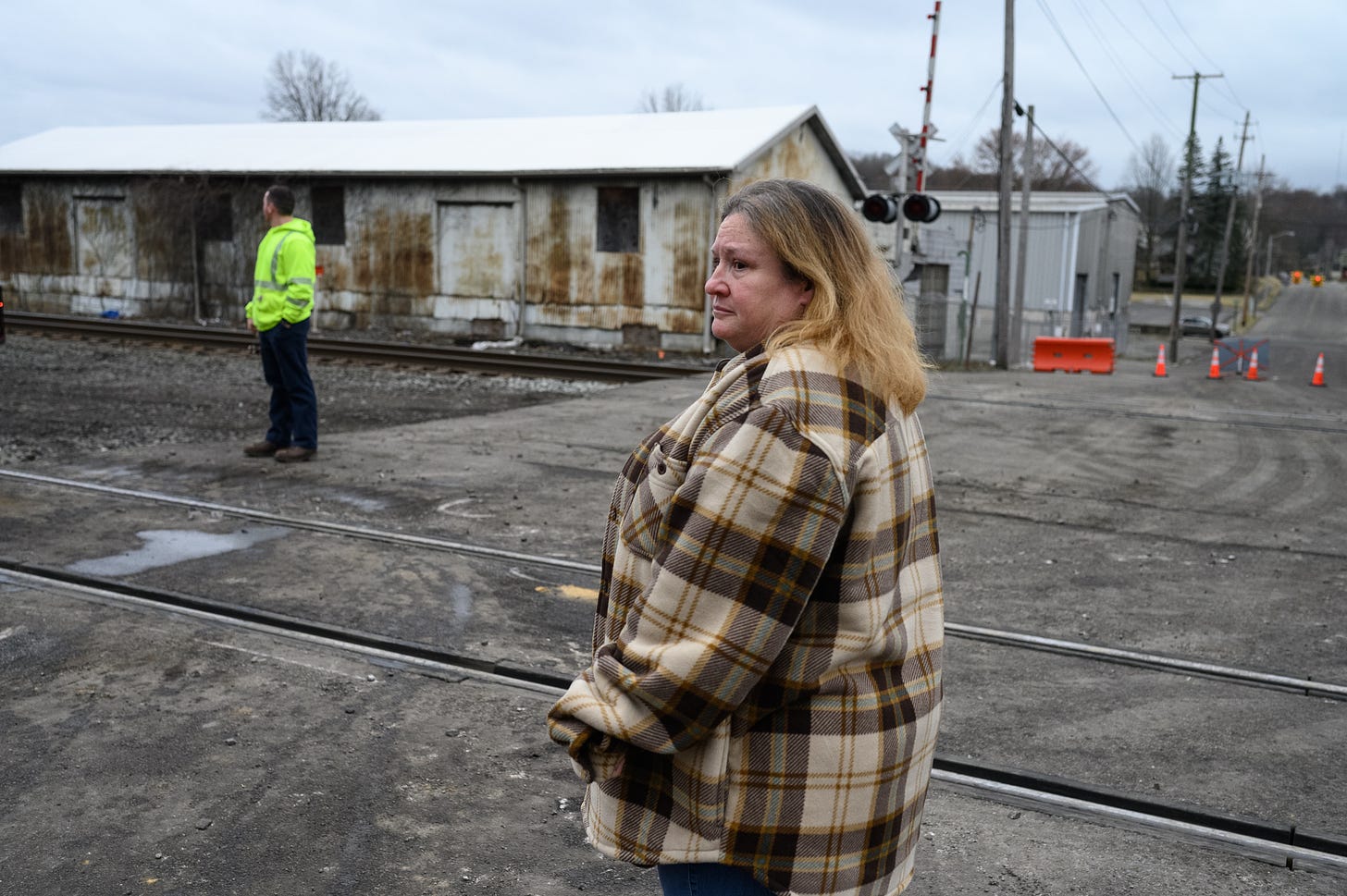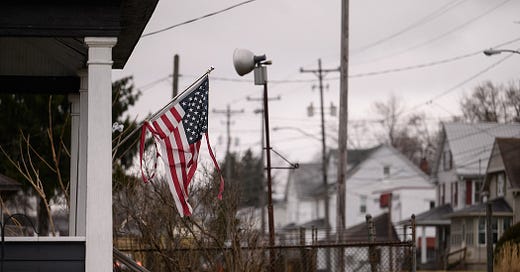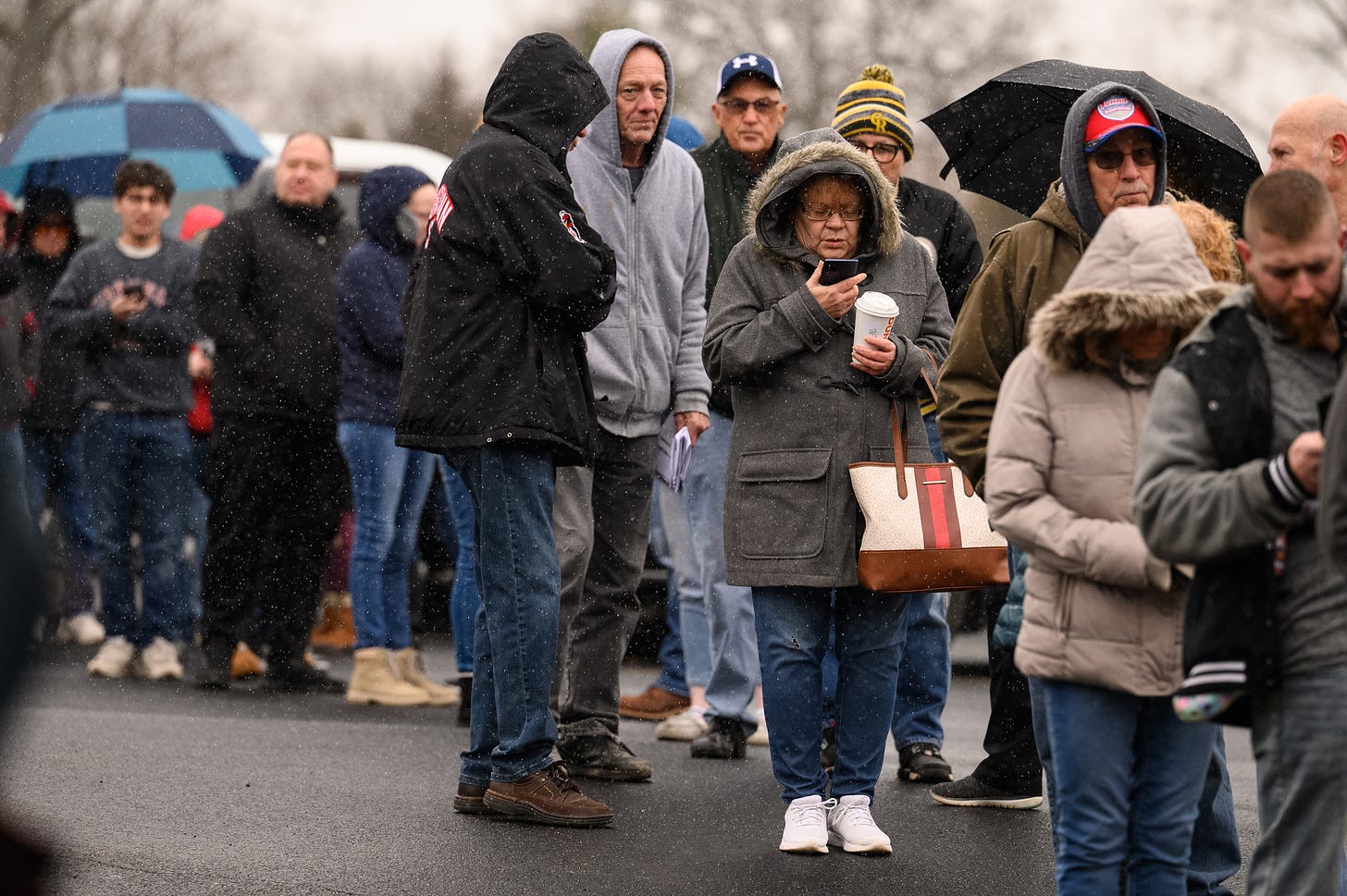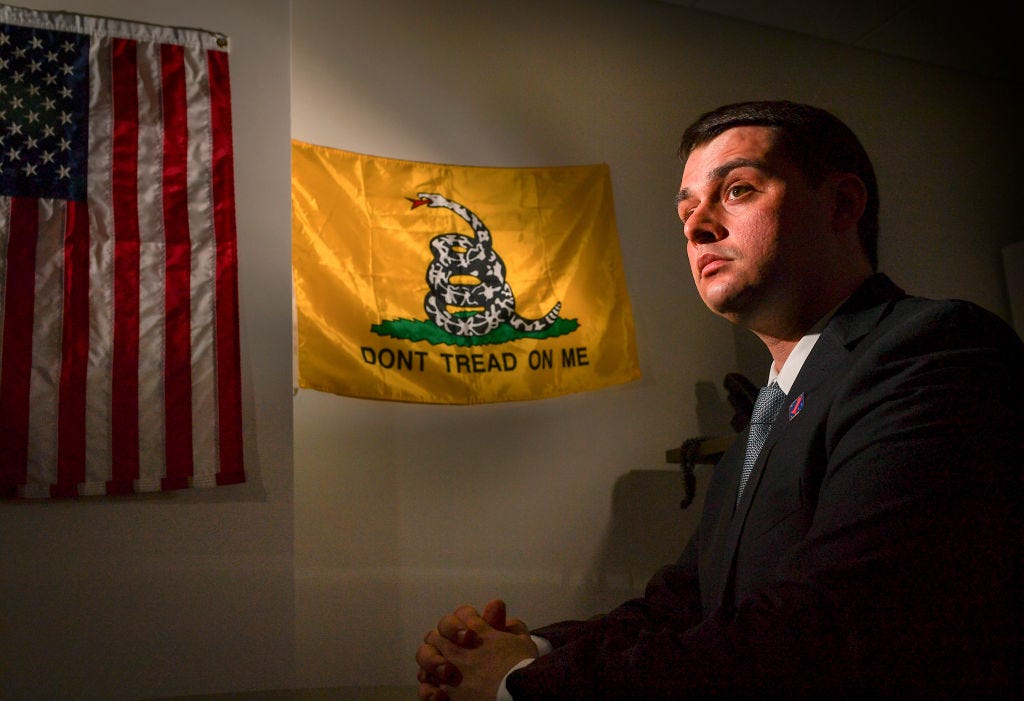
The Free Press

For three decades, Barbara Kugler has lived less than a block from the Norfolk Southern railway line that crosses through East Palestine, Ohio. Up until this month, the sound of an oncoming freight train’s warning whistle—long, long, short, long—used to be a comfort.
But now when she hears it, she tenses.
“For thirty years that sound meant home. It was part of the rhythm of our lives,” says Kugler, 52, who was born and raised in a town one mile away and spends her days minding her grandkids. “Now I find myself flinching every time I hear it because I don’t know what is coming next.”
Just before 9 p.m. on February 3, the noise of a train screeching to a halt followed by a large explosion jolted Kugler and her husband off the couch and out onto the street.

“I thought we needed to get out. This is the end of it. The town’s burning down,” she said.
They saw dozens of railway cars strewn about like a kid’s Tonka trucks, with flames and smoke shooting toward the sky. The blaze was so hot, Kugler said she had to remove her winter coat.
“It was like a bomb going off,” Kugler said. “The cars just hitting and hitting—it was this constant sound of them banging together.”
While no one was injured or killed that night, the chemicals on board the train presented an immediate threat to the town. Most frightening was the flammable gas vinyl chloride, which causes headaches, dizziness, and—in acute cases of exposure—cancer.
Fearing a massive explosion would send shrapnel and toxic fumes soaring for miles, nearly 2,000 residents, including the Kuglers, were evacuated. On February 6, Norfolk Southern officials set off a controlled burn. But even that sent a fireball into the sky, with a black mushroom cloud that looked like something out of Chernobyl.

The people of East Palestine are back, but they don’t feel safe.
Faint traces of soot line the insides of some of their homes. An oddly sweet odor, like fresh bubblegum, also lingers.
I spoke to more than a dozen people over the past few days and many say they feel dizzy and have headaches. They worry about breathing in fumes that cause cancer. “It is a big fear,” said Kaylee Jackson, 40, who does odd jobs for a living. “These chemicals literally got sucked up into the air during the controlled burn and the derailment. Well, where do clouds go? What comes up, must come down.”
Several locals have taken photos of dead fish floating in the nearby creeks. The Ohio Department of Natural Resources estimates the chemical blast affected more than seven miles of streams, killing some 3,500 small fish.

Even so, Ohio’s Environmental Protection Agency insists the five wells supplying the village’s drinking water are clean. The agency also declared the water in 50 private wells and the air quality in over 500 homes free from deadly contaminants.
For the past two weeks, Ohio’s Republican governor Mike DeWine has also tried to reassure the public that their water is safe to drink and their air is safe to breathe. On Tuesday, he made home visits in the town and drank the tap water to prove it.
But few people here trust the authorities. If the fish are dying, why should they? And they’re getting conflicting messages, too. Earlier this week J.D. Vance, Ohio’s newly elected Republican senator, traveled to one of the contaminated creek beds and was filmed scraping its bottom with a branch, sending a bloom of chemicals to the surface.
“This is disgusting,” Vance said in his now-viral video. “The fact that these chemicals are still seeping in the ground is an insult to the people who live in East Palestine.”
Kaylee Jackson doesn’t know who to trust. She refuses to drink water from her tap, and now gets her supply from bottles that local officials are providing to the town. And when she showers, she worries about the chemicals getting into her pores.
“We don’t know what we are breathing, we don’t know what we are drinking,” Jackson tells me while fighting back tears.
Christa Graves, a stay-at-home mom in her fifties, breaks down as she talks about the creeks that were a playground for her and her kids growing up. Her grandkids still play there.
“That was our swimming hole,” she says. “How many years? How many decades? How many generations can we not use any of these resources?”
Many in East Palestine (pronounced Pal-e-steen) are seeking their own independent tests of the air and water. They also want better answers, more federal support, and a proper cleanup that eradicates all chemicals from the ground and the streams, guaranteeing their safety. But because this disaster is deemed man-made rather than environmental, relief from the Federal Emergency Management Agency (FEMA) isn’t coming.
On Wednesday afternoon, former president Donald Trump, who is running again in 2024, came here in an 18-wheeler, bearing food and water supplies. Yesterday, former representative for Hawaii Tulsi Gabbard also tweeted that she had flown in “to see firsthand” what was going on in the town.
But while Trump and Vance and Gabbard are all showing up, the actual people running this country have been missing in action. It took until February 16—nearly a full two weeks after the crash—for the first top Biden official, EPA administrator Michael Regan, to be on the scene. Meanwhile, Secretary of Transportation Pete Buttigieg—who has one job, overseeing the infrastructure of this country—has not yet witnessed the catastrophe in person nor did he acknowledge it until February 13, though he is scheduled to arrive today. President Joe Biden released a fact sheet about the accident and tweeted about it, but he hasn’t given a speech about it, let alone visited the town. In fact, on Monday, he was 5,000 miles away in Kyiv, meeting with the president of Ukraine and pledging more aid in the war against Russia.
That the president ignored East Palestine and chose to make a big splash in a foreign country symbolizes what matters most to the White House, the town’s mayor Trent Conaway said.
“That was the biggest slap in the face,” Conaway fumed on Fox. “That tells you right now he doesn’t care about us. He can send every agency he wants to, but I found out this morning that he was in Ukraine giving millions of dollars away to people over there and not to us… on President’s Day in our country, so I’m furious.”
In the latter half of the twentieth century, Columbiana County, where East Palestine sits, has swung between Democratic and Republican voters. But more recently, blue-collar workers started to feel abandoned by the party and its old-school progressives who once fiercely defended the unions. The last time people here voted for a Democratic president was Bill Clinton in 1996, and the area has been getting redder ever since. In 2016, Trump swept the county by 68 percent. In 2020, he took it by 72 percent.
You could argue the political shift started as far back as September 19, 1977, the day known as Black Monday, when the steel mills started shutting down in Youngstown, in nearby Mahoning County. Thousands of workers lost their jobs, but when the locals tried to deliver a petition to then-President Carter to grant them some relief, “they were largely ignored,” said Paul Sracic, a political science professor at Youngstown State University.

The Biden administration’s refusal to declare East Palestine a disaster area and grant FEMA aid feels eerily similar to Black Monday now, especially as the tragedy comes at a time of worker strife. Last year, two of the country’s largest freight rail labor unions threatened to strike, citing grievances such as staffing shortages and a requirement that workers be on call on short notice as often as seven days a week. Then, in December, Biden stepped in and signed legislation that imposed an agreement between the rail companies, including Norfolk Southern and its workers. A strike was averted, but the workers got little of what they asked for.
“Look, I know this bill doesn’t have paid sick leave that these rail workers and frankly every worker in America deserves,” Biden admitted when he ended the dispute. “But that fight isn’t over.”
He never mentioned it again.
Though early evidence indicates the East Palestine crash was caused by an overheated wheel bearing on a train car, unions claim that rail companies’ push for higher profits is putting safety at risk—and unless something is done, more accidents will happen. Last week, Norfolk Southern railway officials failed to show up for a town hall meeting with locals, claiming in a statement that company representatives feared for their safety.

Lee Boyle sits in the gazebo in East Palestine’s municipal park with his bulldog Cedric. Nearby, a cheery sign declares: WELCOME TO HISTORIC EAST PALESTINE, OHIO: The place to be.
Boyle said he’s furious at the railway bosses. “Look around you. Have you seen anyone here that strikes fear in you? Yes, we are frustrated and angry, but to be afraid of listening to our concerns is insulting,” he said.
Norfolk Southern recently issued a press release saying the company’s CEO and president Alan Shaw met with a handful of folks, including local officials.
But “we had no idea they were here until hours after the CEO was gone and we read it online,” longtime East Palestine resident Tammy Tsai, 62, told me.
Though Norfolk Southern is paying residents $1,000 each to offset the lodging, travel, food, and clothing costs caused by the four-day evacuation, people say it’s little comfort.

“Everything has changed. This was our forever home, my husband has a chiropractic practice here, we have a good life, had a good life, an idyllic life, and all of that changed in an instant,” Tsai said. “The lack of caring that has come from the federal government and Norfolk Southern has been shameful.”
She said it feels like Biden is trying to ride out the clock until the media’s spotlight on her town eventually fades away, “while the clock is subtracting time away from our lives.”
Ironically, just last month, Biden said that progressive Democrats have lost sight of the party’s working-class base. Explaining how he won the 1972 Senate race in Delaware by appealing to blue-collar people and their pragmatic, kitchen-table values, he said: “We didn’t pay nearly as much attention to working-class folks as we used to. And the same thing is happening today.”
David Lonsbrough, an Iraq War veteran who enlisted three months before September 11, said the sights and sounds he experienced the night of the derailment reminded him of being on the battlefield.
Now he is packing to leave East Palestine for a new job in San Antonio.
As he plops down on the sofa he had just been moving, a train rumbles in the distance.
“Every eleven minutes like clockwork, the day they lifted the evacuation, there was already a train waiting on the tracks and the engine started three minutes after we were all told we could return home,” says Lonsbrough, 40.
The CeramFab ceramic fiber factory where he used to work is located right next to the controlled burn. The plexiglass windows there, he says, have melted.
“I had the perfect setup here. I live three blocks from work. I love my job, but after what I saw, I am out of here,” he said.
But what will happen to East Palestine now?
Tsai, an actress who moved here from California and does a fair amount of film and stage work in Pittsburgh, feels like her world has shattered. She said she and her husband Rick are moving to a cabin they own a few miles away until they have a clearer understanding of the fallout.
“In a week or two this will all be gone,” she says, pointing to the media vehicles in the community parking lot. “But our problems are only beginning. We’ve lost our best capital—the values of our home. Now we have to think about what the cost will be on our health, something we may not know for years.”
“Nothing will ever be the same in East Palestine,” she says flatly. “Nothing.”
Salena Zito is a Pittsburgh-based politics writer and co-author of The Great Revolt: Inside the Populist Coalition Reshaping American Politics. This is her first piece for The Free Press.
Join our community and support our journalism by becoming a subscriber today:




















Beats me why everyone is so surprised. All public companies are wrung dry by wall street's push for more profits, there's no Warren Buffet style investment in a tangible sustainable product anymore. Just a desire to see increasing profits on the balance sheets regardless of what is happening at the frontlines of the company. People being pushed to their limits burning out, outsourced work at the cost of quality which turns out to be more expensive to fix. Wall Street is not some mythical creature in the sky, it's everyone's 401K and pension funds. Blood is on everyone's greedy hands.
The Delaware River is essentially a waste dump full of PCB's and Chemicals from the 70's and before. We all know this but no cleanup is proposed including "superfund" sites. We are blind to the destruction of the countries' watershed by Plastics and Chemicals and our High Cancer Risks. No one takes responsibility